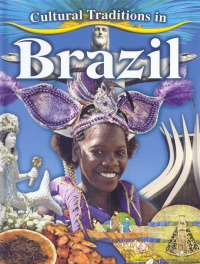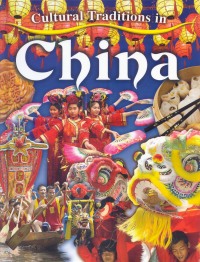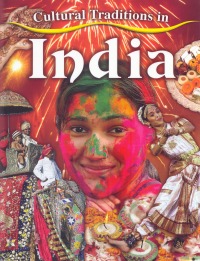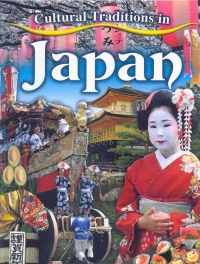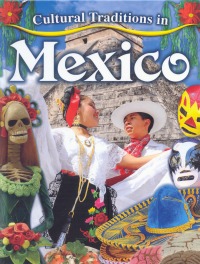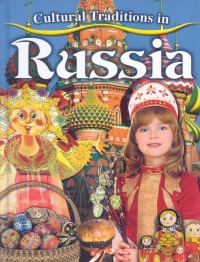| ________________
CM . . .
. Volume XVIII Number 39. . . .June 8, 2012
excerpt:
Designed for young readers, the six-volume “Cultural Traditions in My World” series discusses the various holidays, festivals and celebrations which occur throughout the course of a year in each of the featured countries. Colourful, bright and attractive covers are sure to entice readers. Each of the books has 14 chapters with the holidays arranged chronologically. Topics include the religious, seasonal or family significance of the holiday as well as some of the foods, customs and activities associated with it. “Did you know?” boxes provide interesting trivia, while vibrant colour photographs add to the books’ visual appeal. (The inclusion of a map of the world, showing the location of the featured country, would have been beneficial.) Text is printed in a large, simple font suitable for the books’ intended audience, yet there are some inconsistencies in vocabulary. For example, statements such as “they mixed their pleas to the public with declarations of national pride” would be beyond the comprehension of the average second or third grader. There are also a few typographical and grammatical errors, some omissions in the explanations of the reasons for the holidays or some of the customs, and one or two examples of photographs which are not directly related to the text. On the whole, however, the series will be of use in the primary classroom. A table of contents, an index and a glossary are provided. Cultural Traditions in Brazil reflects the joie de vivre of the Brazilian people and the combination of the Portuguese and indigenous people’s beliefs and customs. Religious holidays include Christmas, during which children leave their shoes near an open window in hopes that Papai Noel will fill the shoes with small gifts; the Fiesta de Iemanjá, named for the goddess of water for whom people place offerings of perfume, flowers and rice in tiny boats and set them afloat on the river as thanks for the previous year and in anticipation of a good year ahead; and Easter, which, in many cities, is celebrated with a processional walk to church on Easter Sunday. (One very interesting photo shows a colourful patterned walkway made out of sawdust and rice husks.) But the most exciting religious holiday of all in Brazil is the four-day Carnaval, held 40 days before Easter and characterized by parades, dancing, singing and vibrant, elaborate costumes. The most famous Carnaval is held in Rio de Janeiro. Brazilians also commemorate All Souls’ Day and several feast days honouring saints, perhaps the most important one being Our Lady of Aparecida, named for the patron saint of Brazil. Indian Day, on April 19th, celebrates Brazil’s indigenous people and is characterized by cultural traditions, such as body art, music and crafts, as well as sporting competitions. Other holidays include Labor Day, Tiradente Day, which honours a leading member of the country’s revolutionary movement, Soldier’s Day, Independence Day, celebrated in part with an air show, and Republic Day. Cultural Traditions in China begins with an explanation about the two calendars used in China, the Gregorian for everyday activities, such as school and appointments, and the Chinese lunar calendar which is used to determine the dates of the various holidays. Among other holidays and festivals, this title features family occasions, Chinese New Year, the Qing Ming Festival, May Day, Children’s Day, the Dragon Boat Festival and the Chong Yang Festival. Secular holidays, such as International Women’s Day, are also mentioned. There are a few gaps in the information presented in this book. There seems to be too much focus on whether or not the people get the day off work or school on the featured holiday, and not enough emphasis on the meaning behind the holiday. For example, why do children typically fly kites on the Qing Ming Festival (also called Tomb Sweeping Day, which honours deceased relatives) and what does going to the opera have to do with the holiday? Despite these flaws, children will be interested in some of the customs related to many of the holidays, such as eating traditional birthday party foods- peaches and noodles- because they are symbols of long life, lighting firecrackers on New Year’s to scare off evil spirits, and burning paper money during the Qing Ming Festival in the belief that their ancestors’ spirits will help them to get what they most desire. Of all the titles in this series, Cultural Traditions in India is, perhaps, the most interesting on account of the many unique holiday traditions. The three to four-day Pongal is a colourful harvest festival during which people offer pongal (a sweet rice pudding) to the rain gods on the first day and to Surya, the sun god, on the second day. On the third day, they clean their cattle, considered to be sacred, and decorate the cattle with flower garlands, bells and coloured powders. Celebrants of Holi, which marks the beginning of spring, throw water and powders of different colours at one another. During Raksha Bandhan, honouring the bond between brothers and sisters, a sister ties a rakhi, a type of bracelet made of interwoven red and gold threads, (considered to be sacred), around her brother’s wrist to symbolize the brother’s lifelong protection of his sister. Ganesh Chaturthi is held in celebration of the birthday of Ganesha, the Hindu elephant god of success, education and wealth and destroyer of evil and obstacles. During this festival, people make clay models of Ganesha and offer gifts of coconuts, flowers and camphor, and on the last day of the festival, they carry their models through the streets and down to the river where they immerse the statues in water, symbolizing the washing away of misfortunes and obstacles. India has three national holidays: Republic Day, during which there are parades with floats and police riding on camels; Independence Day, and Gandhi Jayanti, which celebrates the birthday of spiritual and political leader Mohandas Gandhi, known as “the Father of the Nation”. Other holidays include Buddha Purnima, one of the most sacred Buddhist holidays, Eid al-Fitr, the three-day Muslim celebration at the end of Ramadan, and Diwali, the festival of lights. Many of the holidays celebrated in Japan reflect one of the country’s two main religions, Shinto and Buddhism. Some of the highlights in Cultural Traditions in Japan are the Spring Festival (also known as Setsubun), the Doll, Flower, Obon and 7-5-3 Festivals, as well as Health and Sports Day, begun after the 1964 Tokyo Summer Olympics, Culture Day and the emperor’s birthday. Children will find some of the holiday customs quite interesting. For instance, at the 7-5-3 Festival, which celebrates children who are turning seven, five, and three years old, families attend a Shinto shrine to get blessings, and the children receive thousand-year candy, long sticks of candy which symbolize long life, while at the Flower Festival, which celebrates the birthday of Buddha, people take decorated statues of Buddha to Buddhist temples and pour sweet tea over the statues’ heads, as though they are bathing an infant. Throughout this book, the Japanese people’s reverence for nature is most evident. Mexico’s culture is a mix of Aztec, Mayan and Spanish traditions. Today, most Mexicans are Roman Catholic; therefore, many of their holidays are religious in nature. In Cultural Traditions in Mexico, there is information about religious holidays, such as Name Day and All Saints’ Day, Carnival, which is celebrated just before the Lenten season begins, Easter, Day of the Dead, Day of Our Lady Guadalupe (which refers to Jesus’s mother, Mary), and Christmas. Mexicans also celebrate the birthday of Benito Juarez, Mexico’s first indigenous president and said to have been the best president that Mexico ever had, Cinco de Mayo, which commemorates Mexico’s defeat of the French army, and Mexican Independence Day. Similar to April Fools’ Day, during which people play harmless pranks on each other, is Day of the Innocents, celebrated on December 28th. Other topics in this title include birthday and wedding customs and special family days honouring different members of the family. Some examples are Mother’s Day which sometimes involves mariachi bands serenading moms, and Children’s Day which is marked by a day off school, parades, gifts, and donations for orphans or needy children. Interesting New Year’s customs include wearing yellow underwear on New Year’s Day in order to bring good luck with money, or red underwear for good luck in love; and eating 12 grapes at midnight, making a wish after each grape (though it is never stated, one would assume that each of the grapes represents a month of the year). Cultural Traditions in Russia focuses on fewer religious holidays than the other titles and more on commemorative holidays which honour war heroes (Defender of the Motherland Day and Victory Day), inventors (Radio Day, which pays homage to Alexander Stepanovich, a physicist and inventor of the radio), space exploration (Cosmonautics Day), women’s equality, independence and national unity. Following the New Year, most Russians celebrate Christmas on January 7th with a 12-course dinner. Maslenitsa signals the end of winter and the beginning of spring and Lent. At this time, it is customary to make a scarecrow, representing winter and to set fire to it on the last day of the holiday to symbolize winter’s end. Other religious holidays include Easter in April or May, and Ivan Kupala Day on June 24th which, in early Orthodox Church history, marked the first day that people were allowed to swim in rivers and ponds (no explanation is given for this custom) and the night when evil spirits and wood goblins roamed the Earth. Somehow, these two facets of the holiday seem unrelated, as does the fact that unmarried girls wear flower garlands in their hair on this day. In Russia, there are many other ethnic groups that have their own holidays, some of which are the Buryats’ celebration of Surkharban after the crops have been sown, the Muslims’ festival of Navruz, marking the arrival of spring, and the Tatars’ summer festival called Sabantuy which includes traditional sporting competitions, such as wrestling, horse racing and pillar climbing as well as games typically played at family picnics, such as sack races and three-legged races. Individually, these titles provide a snapshot of yearly celebrations in various countries, but viewed as a series, they afford readers an opportunity not only to gain an appreciation of other cultures, but also to compare and contrast the holidays. Astute readers will discover that all cultures have similarities, marking rites of passage (birthdays, weddings), the coming and going of the seasons, national pride, and religious holidays, and they will realize that people all over the world are actually more alike than they are different. Recommended. Gail Hamilton is a former teacher-librarian in Winnipeg, MB.
To comment on this title or this review, send mail to cm@umanitoba.ca. Copyright © the Manitoba Library Association. Reproduction for personal use is permitted only if this copyright notice is maintained. Any other reproduction is prohibited without permission.
NEXT REVIEW | TABLE OF CONTENTS FOR THIS ISSUE - June 8, 2012. AUTHORS | TITLES | MEDIA REVIEWS | PROFILES | BACK ISSUES | SEARCH | CMARCHIVE | HOME |
